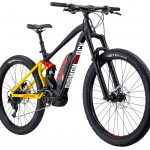This probably isn't going to be the answer that you are looking for, but to be honest, I just get on the bike and ride it, and give no thought to the geometry of either bike. The two things that make a difference to me are tyres that have an aggressive edge pattern to the tread, and the recent addition of the dropper seat post to both bikes. I need to change the tyres on the had tail to something like Hutchinson Toros, that still offer reasonable rolling, but also have a decent side edge, which is something very desirable when riding the very narrow and rutted local terrain.
At the organised mtb bike shop ride a couple of weeks ago, I was out with a group who predominantly ride down hill. A couple of the lads were saying that I should do this, do that, and switch to a short stem.
I didn't say anything at the time, but I thought what utter ******. People, example above with SW, read far too much into what they see on the internet, and get sucked in.
My point being that yes a shorter stem would mean that I am in a potentially better position to ride down hill, but if those lads had stopped to think about it a bit more, I had never ridden down hill as such before, was riding a bike with considerably less suspension travel, and no short stem, but in the scheme of things I wasn't exactly too far behind them by the end of each run.
Of more importance is something that they and SW are missing the point of, and that is what the purpose of eMTB actually is. Surely the first and most important point, is that eMTB is designed to make climbing easier, and hopefully if desired, faster as well. By shortening the stem as suggested, you are having the opposite effect of what is desired. The bulk of my riding involves climbing, and more often than not, there is at least one climb per ride that is always very debatable about whether or not you can make it to the top. Sometimes these climbs are just metres long, sometimes they are hundreds of metres long.
I really can't say that I have yet really noticed any major difference between the two bikes, both do the job, but what I really prefer about the hardtail, is how connected and solid that everything feels. It is seemingly tighter and neater to ride, hopping over things is a doddle, it's lighter, and the rigid back end makes climbing so much better with zero squat, and I love the idea of no maintenance to the rear end. Riding the FS bike last night, didn't give me the same buzz.
Thinking about it again, there were actually two occasions that I would have preferred the FS bike on the recent South Downs ride. Once when going down a long descent across a field that had previously been used to graze cattle in, and the constant dip into the now hardened hoof prints marks, wasn't exactly comfortable. The second time was going down a long chalk track that had loads of small drops/steps.
Sorry that my reply wasn't perhaps what you were looking for, but as said, I just get on and ride.
.
Cheers Eddie - that's helpful info regardless of whether or not you notice a difference.
Great to read why you prefer the hardtail overall as those are exactly the reasons I'd like to go hardtail with my next bike, assuming my demo-ing doesn't identify any material compromises I'll be unwilling to make.
There's no doubt in my mind that full sus is overall more comfortable, but the connectedness, the tightness, the overall feeling of solidity, etc. really appeals. I'll let you know how my demo goes.














